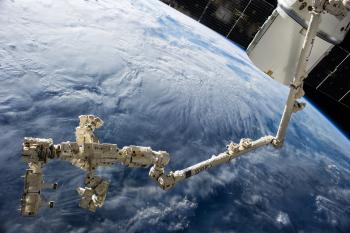- Home
- Agencies
- Department of Agriculture
- Department of Housing and Urban Development
- General Services Administration
- Department of Commerce
- Department of the Interior
- National Aeronautics and Space Administration
- Department of Defense
- Department of Justice
- National Science Foundation
- Department of Education
- Department of Labor
- Office of Personnel Management
- Department of Energy
- Department of State
- Small Business Administration
- Environmental Protection Agency
- Department of Transportation
- Social Security Administration
- Department of Health and Human Services
- Department of the Treasury
- U.S. Agency for International Development
- Department of Homeland Security
- Department of Veterans Affairs
- Goals
- Initiatives
- Programs
Off the Earth, for the Earth
The continued operation and use of the International Space Station (ISS) is critical to achieving NASA’s and the Nation’s goals in conducting science, demonstrating technology, enabling a commercial market in low-Earth orbit, and propelling human spaceflight into the solar system. The space station enables humanity to have an ongoing presence in space and allows crew members to conduct scientific research that cannot be done anywhere else. The space station is the world’s only orbiting, microgravity research and development laboratory, where investigators can perform multidisciplinary research in science and technology to advance benefits for humanity, prepare for our exploration of the solar system, foster commercial investment in space and enhance international cooperation and understanding.
NASA has a priority goal to increase the use of the internal and external research facilities on the space station. (More information is available at http://go.usa.gov/skCk.) In July 2014, the station program reached a milestone of 5,000 consecutive days of humans living and working in space. Since research began in November 2000, more than 1,550 investigations and 24,000 hours of research have been conducted in biology, physical science, technology, human physiology and Earth and space science, with a number of these investigations being student experiments. Eighty-two countries have participated in station research and education activities, and 214 people have lived and worked aboard the space station.
The research occurring aboard the space station is helping NASA prepare to send astronauts into deep space, and is providing tangible benefits to everyone on Earth. The Canadian-built robotic arm that helps astronauts move equipment and experiments around the outside of the station has provided the technology doctors are using in operating rooms to perform highly delicate brain surgery. Research into understanding why astronauts lose bone density at higher rates than people on Earth is leading to better treatment for people afflicted with osteoporosis. The technologies NASA uses to recycle water aboard the space station is helping ensure that people in disaster areas and places with little fresh water have potable water. The station continues to provide a destination for researchers to develop as yet unknown benefits that will improve life on Earth. In addition, NASA has partnered with the Center for the Advancement of Science in Space to increase research and use of the ISS national laboratory with non-NASA organizations including private industry, other government agencies, and academic and educational institutions.
During fiscal year 2014, NASA and its U.S. commercial resupply service providers conducted four trips to the space station through the successful launches of several commercial cargo flights to the orbiting outpost from the United States. The loss of Orbital Sciences' third commercial resupply mission in October, while regrettable, actually served to display the robustness of NASA’s commercial resupply strategy of dissimilar redundancy, and Orbital recently announced its go forward plan to ensure it meets its contractual obligation to deliver supplies to the space station. In addition to delivering science and technology development hardware, crew supplies and spare parts to the station, some of the resupply missions also serve as an opportunity for the astronauts aboard the station to return research samples to Earth for analysis. NASA's commercial resupply providers ensure a robust national capability to deliver critical science to and from orbit, allowing the agency to maximize the potential of the space station; deliver critical benefits to our nation and the world; and maintain American leadership in space. These transportation systems significantly increase NASA’s ability to conduct new scientific investigations.
The announcement by the Obama Administration in January to support the extension of the orbiting laboratory to at least 2024 provides NASA a decade to help transition low-Earth orbit from exclusive to accessible and offers scientists and engineers the time they need to ensure the future of exploration, scientific discoveries and economic development. The ability to extend our window of discovery aboard the International Space Station through at least 2024 will provide the opportunity to develop the tools needed for future deep space missions while reaping large benefits for humanity. Expanding the timeframe for testing essential technologies and hardware related to long-duration journeys, such as to an asteroid or Mars, is the first step in human deep space exploration.
For more information about the International Space Station, please see http://www.nasa.gov/mission_pages/station/main/index.html.





